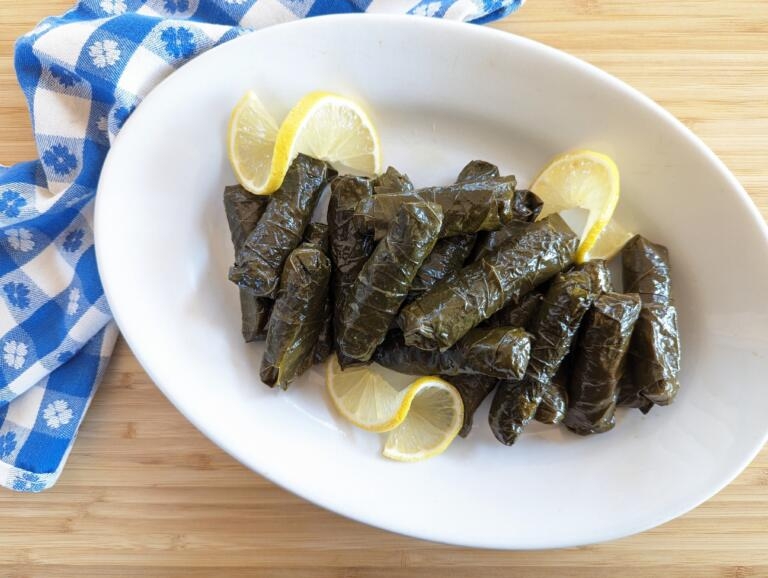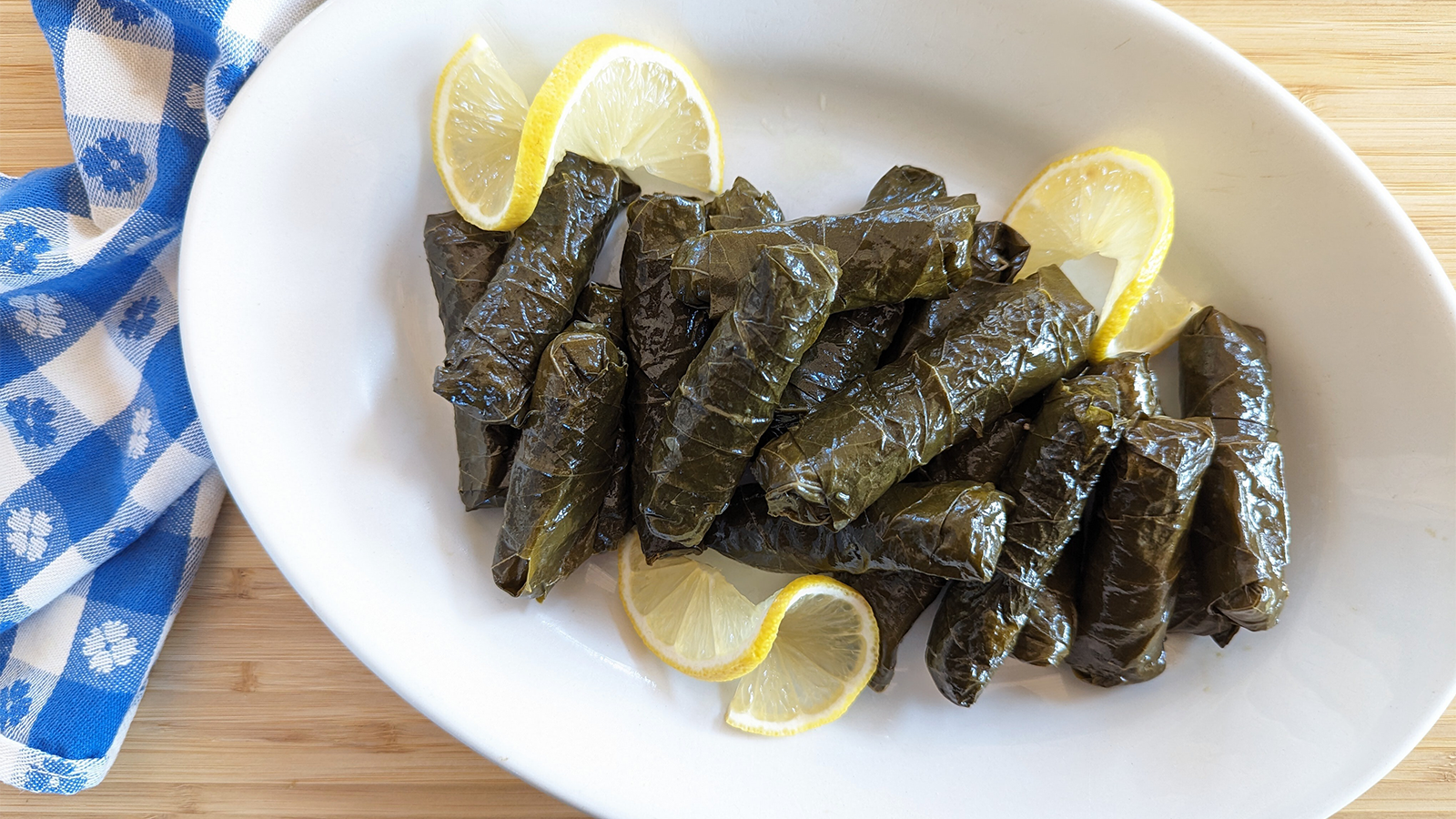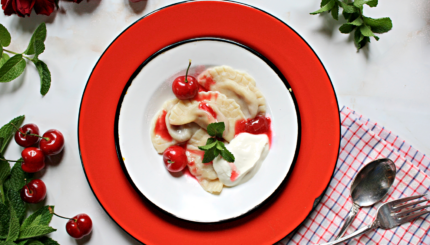Before we get into the dish itself, can we talk about what stuffed grape leaves are called? Most of us know these tasty rolls as “dolma,” but that’s not totally accurate. Dolma comes from the Turkish word “dolmak” meaning “to be filled” or “stuffed.” This is actually the general name for many stuffed dishes, most with vegetables, with roots in the Ottoman Empire. In Turkish, stuffed grape leaves are known more precisely as “yaprak sarma” — yaprak meaning “leaf” and sarma, “wrapped thing” or “yaprak dolma.”
I grew up making lemony stuffed grape leaves we called yaprakas (or yaprakes). This was typical in some parts of the Ottoman Empire, where Sephardi Jews adopted the Greek influence of cooking with lots of lemons, including my grandmother’s hometown of Monastir, now called Bitola, in Macedonia.
By any name, for Sephardi Jews and many people in the Balkans, Mediterranean and Middle East, stuffed grape leaves are a must to serve to families, guests and always for special occasions, when women would gather to fix large quantities of the quickly consumed rolls.
Stuffed grape leaves are cooked slowly for tenderness and packed tightly in the pan so as not to unravel as the rice expands. While the cooking method is similar wherever grape leaves are prepared, the ingredients and flavors vary. In addition to grape leaves, the wrapping can be done with cabbage or chard leaves. Rice is usually used, although bulgur is another option. The filling can be vegetarian or include ground meat (beef or lamb). Turkish yaprak sarma feature pine nuts, currants and warm spices like cinnamon and allspice. Some Sephardi Jews, including those with a heritage from Rhodes, cook and serve the stuffed rolls on top of white beans in light tomato sauce.
The Nosher celebrates the traditions and recipes that have brought Jews together for centuries. Donate today to keep The Nosher's stories and recipes accessible to all.
Serve these stuffed grape leaves as part of a mezze or assorted appetizers, or as a main dish with a salad and flatbread. The only problem is that your family and guests will always want more!
Notes:
- The rice stuffing can be adapted for Sephardic stuffed vegetables. I like to add sautéed small-diced onions and chopped mushrooms, as well as some brown or green lentils to the rice mixture before stuffing.
- The stuffed grape leaves will keep for up to 5 days in the refrigerator.

Lemony Stuffed Grape Leaves (Yaprakas) Recipe
Serve these stuffed grape leaves as part of a mezze or assorted appetizers, or as a main dish with a salad and flatbread. The only problem is that your family and guests will always want more!
- Total Time: 1 hour 45 minutes
- Yield: 36-40 rolls
Ingredients
- 4 large lemons
- 1 cup uncooked long-grain white rice, preferably basmati
- 1 16-ounce jar brined or fresh grape leaves
- ½ cup finely chopped parsley, or 2 Tbsp dried
- ¼ cup finely chopped fresh dill, or 2 Tbsp dried
- ¼ cup fresh mint leaves, chopped fine, or 1 ½ tsp dried
- ½ tsp salt, or to taste
- ¼ tsp pepper, or to taste
- 2 Tbsp olive oil
Instructions
- Zest and juice 2 of the lemons and set aside. Thinly slice the remaining two lemons and set aside, in a separate bowl.
- Boil 5-6 cups of water in about a 4-quart pot. While the water is coming to a boil, put the rice in a fine mesh strainer and wash very well under cool water until the water draining off the rice runs clear. This washes off the starch, which helps keep the cooked grains of rice from sticking together.
- When the water comes to a rolling boil, put in the rice and ½ tsp salt, and let it boil until al dente, about 8-9 minutes for basmati rice. Pour the rice into a mesh strainer and immediately rinse with cold water to stop the cooking. Set aside over a large bowl to drain.
- To prepare jarred, brined grape leaves: drain and carefully take leaves out of the jar. Gently and carefully unroll the bundles of leaves, putting them in a colander. Set the colander in a bowl of cool water to briefly soak the leaves, then remove the colander and rinse the leaves again under cold water. Drain the leaves by hanging them over the edges of the colander and empty bowl, then sort into large, small and torn pieces. Continue with Direction 6.
- To prepare fresh vine leaves: separate them and rinse one by one. Boil a pot of water and remove from the heat. Put all the leaves in the boiled water for 5 minutes, then drain in a colander.
- To make the filling, put the drained rice in a mixing bowl. Add the lemon zest, parsley, dill, mint, salt and pepper, and gently mix well.
- In a wide 5- to 6-quart pot or deep skillet, put about 1 Tbsp olive oil and swirl it around to cover the bottom, or use a pastry brush to spread it. Cover the bottom of the pan completely with torn pieces of leaves, overlapping the edges. Supplement with some of the smaller leaves if needed. Lay a single layer of lemon slices over the bottom. This will keep the stuffed leaves from sticking and add flavor.
- To fill the leaves, work one by one. Lay a large leaf flat on your work surface, shiny side down with the duller vein side up. Use a small, sharp knife to carefully cut off any stem remaining close to the bottom of the leaf. Place about 1 Tbsp of the rice mixture on the leaf, centered and up a little bit from the bottom edge.Gently spread out the filling into a compact, even line about 2-3 inches long depending on the size of the leaf. You want to leave enough empty leaf on each side to fold over. Fold the bottom of the leaf tightly over the rice, then fold the right and left sides of the leaf from the edges of the rice over toward the center. Continue to roll the leaf tightly from the bottom to the top, creating a log or cigar shape.
- As you roll each grape leaf, add it to the pot with the top- or seam-side down. Pack them tightly so they won’t open up while cooking. When the bottom of the pot is full, add another layer in the opposite direction on top. Once all the stuffed leaves are in the pot, add a layer of the remaining lemon slices.
- Mix the juice from the two lemons with the remaining 1 Tbsp oil and 1-2 cups water depending on the size of the pan. Pour the mixture evenly over the stuffed leaves. Add more water if needed to make sure the liquid comes up about 1/4 of the way. Place an inverted flat, heat-proof plate on top of the leaves and lemon slices to keep the rolls from opening as the rice finishes cooking and expands. Cover the pan with a tight-fitting lid, bring to boil over medium-high, then reduce heat to low and simmer for 1-1½ hours until the leaves are soft. Check occasionally to make sure there is still liquid in the bottom of the pan, adding more water if needed.
- To serve, arrange the yaprakas on a platter and serve at room temperature with wedges of fresh lemon.
Notes
- The rice stuffing can be adapted for Sephardic stuffed vegetables. I like to add sauteed small-diced onions and chopped mushrooms, as well as some brown or green lentils to the rice mixture before stuffing.
- The stuffed grape leaves will keep for up to 5 days in the refrigerator.
- Prep Time: 30 minutes
- Cook Time: 1 hour 15 minutes
- Category: Appetizer
- Method: One-Pot
- Cuisine: Sephardic




Many thanks for the recipe, and appreciated the discussion of different names for the dish — “yaprak, and “dolma.” In my family the term was “yalanji”, from the Turkish for “liar” or “fake.” As my mother explained it, that designation came from the expectation that the grape leaves were stuffed with meat, but they turned out to be vegetarian!
This looks great . ?s. 1What to add to the ground beef and use it raw? 2 I can use the leaves right out of my vineyard? I I soak and fry them can I vacupac and freeze the leaves for later?
Thanks
You’re making me hungry!
Love dolmas and look forward to learning more.
Shalom & thank you,
Margi in Sacramento
In my family too, they are yaprakas. I’ve been eating them out of the can since the older generation passed on, but with this recipe, a wonderful new project for my mother and myself has arisen. Thank you to The Nosher.
Can you freeze yalraki
Hi Clair, you can freeze these for 3 or so months.